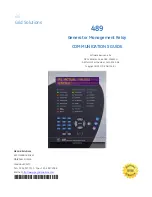
3-8
Differential, Restricted Earth Fault,
Date Code 20020129
Overcurrent, Voltage, and Frequency Elements
SEL-387E Instruction Manual
':*0
'&%/
0LQ
0D[
B
'&5)
'&5
6
6
'LIIHUHQWLDO&XUUHQW
Figure 3.7: DC Blocking (DCBL1) Logic
Setting Descriptions
Differential Element Enable (E87W1 through E87W3)
Range: Y, N, Y1
The SEL-387E Relay has three sets of three-phase current inputs. Depending on the application,
you may not need all of these inputs for the differential zone of protection. You can configure
any unused terminals for stand-alone overcurrent protection. The E87Wn setting specifies which
of the terminals the relay is to include in the differential calculation. An independent setting,
EOCn, exists to enable the overcurrent and demand metering elements. Selecting Y for E87Wn
enables differential element settings for the corresponding winding. Selecting N for E87Wn
disables differential element settings for the corresponding winding; the relay hides the settings,
and they are unavailable for use.
Selecting Y1 makes the fourth-harmonic (PCT4), dc ratio blocking (DCRB), and harmonic
restraint (HRSTR) settings available. This is the only difference between Y and Y1 selection.
CT Connection (W1CT through W3CT)
Range:
D, Y
To perform calculations for TAPn values, the relay uses information on whether the CTs are
connected in delta (D) or wye (Y) for each winding. If the CTs are connected in delta, the relay
raises the TAP value by a factor of 1.732.
CT Ratio (CTR1 through CTR3)
Range:
1–50000
Determine the CT ratio by dividing the nominal primary CT current by the nominal secondary CT
current. If, for example, the nominal primary CT current is 2000 A and the nominal secondary
CT current is 5 A, the ratio is 2000/5 or 400. For this example, enter a value of 400.
















































